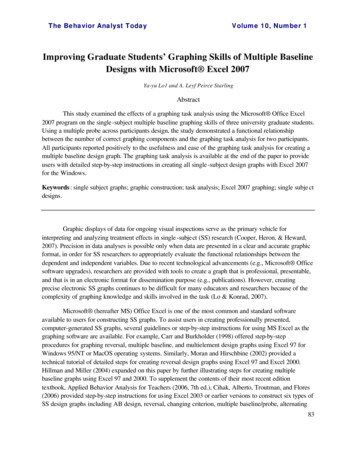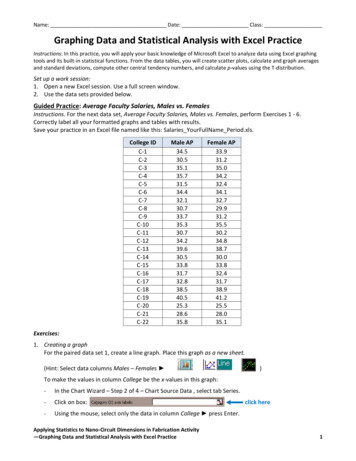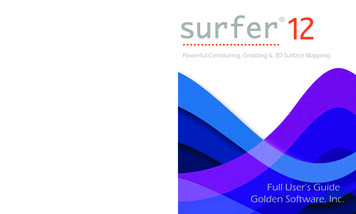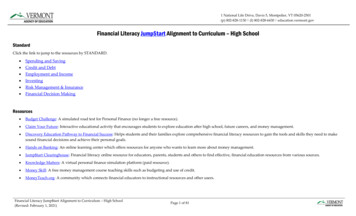
Transcription
The Behavior Analyst TodayVolume 10, Number 1Improving Graduate Students’ Graphing Skills of Multiple BaselineDesigns with Microsoft Excel 2007Ya-yu Lo1 and A. Leyf Peirce StarlingAbstractThis study examined the effects of a graphing task analysis using the Microsoft Office Excel2007 program on the single -subject multiple baseline graphing skills of three university graduate students.Using a multiple probe across participants design, the study demonstrated a functional relationshipbetween the number of correct graphing components and the graphing task analysis for two participants.All participants reported positively to the usefulness and ease of the graphing task analysis for creating amultiple baseline design graph. The graphing task analysis is available at the end of the paper to provideusers with detailed step-by-step instructions in creating all single -subject design graphs with Excel 2007for the Windows.Keywords : single subject graphs; graphic construction; task analysis; Excel 2007 graphing; single subje ctdesigns.Graphic displays of data for ongoing visual inspections serve as the primary vehicle forinterpreting and analyzing treatment effects in single -subject (SS) research (Cooper, Heron, & Heward,2007). Precision in data analyses is possible only when data are presented in a clear and accurate graphicformat, in order for SS researchers to appropriately evaluate the functional relationships between thedependent and independent variables. Due to recent technological advancements (e.g., Microsoft Officesoftware upgrades), researchers are provided with tools to create a graph that is professional, presentable,and that is in an electronic format for dissemination purpose (e.g., publications). However, creatingprecise electronic SS graphs continues to be difficult for many educators and researchers because of thecomplexity of graphing knowledge and skills involved in the task (Lo & Konrad, 2007).Microsoft (hereafter MS) Office Excel is one of the most common and standard softwareavailable to users for constructing SS graphs. To assist users in creating professionally presented,computer-generated SS graphs, several guidelines or step-by-step instructions for using MS Excel as thegraphing software are available. For example, Carr and Burkholder (1998) offered step-by-stepprocedures for graphing reversal, multiple baseline, and multielement design graphs using Excel 97 forWindows 95/NT or MacOS operating systems. Similarly, Moran and Hirschbine (2002) provided atechnical tutorial of detailed steps for creating reversal design graphs using Excel 97 and Excel 2000.Hillman and Miller (2004) expanded on this paper by further illustrating steps for creating multiplebaseline graphs using Excel 97 and 2000. To supplement the contents of their most recent editiontextbook, Applied Behavior Analysis for Teachers (2006, 7th ed.), Cihak, Alberto, Troutman, and Flores(2006) provided step-by-step instructions for using Excel 2003 or earlier versions to construct six types ofSS design graphs including AB design, reversal, changing criterion, multiple baseline/probe, alternating83
The Behavior Analyst TodayVolume 10, Number 1treatments, and multi-treatments designs. Finally, Lo and Konrad (2007) expanded on previo uspublications by refining and detailing two task analyses specific for creating various SS single data pathand double data paths graphs using Excel 2003 or earlier versions. In addition to the aforementionedguidelines in using MS Excel program for graphing SS research data, tutorials or instructions for creatingSS graphs are also available to users with either MS Word for Windows 2003 and Mac 2004 (Grehan &Moran, 2005) or MS PowerPoint 2003 and MS PowerPoint for Mac (Barton, Reichow, & Woolery,2007).Despite the availability and usefulness of various approaches or instructions for creating SSgraphs using MS software programs, previous published guidelines become impractical for users whoadopt the newest version of MS Office 2007 program. This new version presents drastic changes incommands and toolbars compared to its earlier versions, making it very difficult for users to follow whenusing MS Office 2007. Recently, Dixon et al. (in press) updated the graphing task analyses by Carr andBurkholder (1998) and provided new task analyses for creating SS graphs in Excel 2007. Using abetween-subject design, Dixon et al. compared the Excel 2007 SS graphing skills of 22 graduate studentsusing either the Carr and Burkholder or the new task analyses. The authors found that participants whoreceived the new task analyses created SS graphs more quickly and accurately than those using the Carrand Burkholder procedure. The three sets of task analyses (i.e., reversal designs, multielement designs,and multiple baseline designs) by Dixon et al. are very timely and useful; however, some Excel 2007users may benefit from streamlined task analyses that attend to the following aspects not addressed inDixon et al. task analyses: (a) setting data points to fall on the tick marks of x axes, (b) raising the 0 offthe x axes while maintaining appropriate scales, (c) providing appropriate and consistent scales on the xand y axes, (d) offering instructions for creating multiple data paths on one graph, (e) offering variousgraphics accompanying key steps throughout the task analyses, and (f) providing detailed instructions forinserting new columns for additional information (e.g., dates or conditions), organizing data and graphworksheet tabs, or editing various aspects of graphs such as textboxes, data point markers, and data pathlines. Additionally, with the Dixon et al. task analyses, Excel 2007 users may find it difficult to completea multiple baseline graph without following through and memorizing steps for creating reversal designgraphs as some steps were referenced back to the first task analysis for reversal designs.To supplement the aforementioned graphing components not addressed in the task analyses byDixon et al. (in press) and to meet the needs of an increasing number of Excel 2007 users in creating SSgraphs, the purposes of this paper are twofold. First, this paper provides a detailed task analysis forconstructing various SS graphs using Excel 2007 program. The task analysis mirrors those provided byLo and Konrad (2007) and provides steps for Excel 2007 users to address graphing “gaps” found in Dixonet al. instructions. Second, the effectiveness of a graphing task analysis depends on its validation throughempirical research and a rigorous research design. We conducted a multiple probe across participantsdesign study to evaluate the effects of the Excel 2007 graphing task analysis on the graphing performanceof three university graduate students. In addition, the participants completed a consumer satisfactionquestionnaire to express the acceptability and utility of the graphing task analysis.84
The Behavior Analyst TodayVolume 10, Number 1MethodParticipants and SettingsThree female graduate students majoring in special education at a university in southeastern U.S.volunteered to participate in this study during a summer semester. Due to the participants’ variousschedules and obligations during the summer term, the implementation settings and technologyequipment also varied across the participants.Hannah was a part-time graduate student pursuing a Masters in Education (M.Ed.) degree inspecial education. At the time of the study, Hannah was three fourths into her program completion andwas at her initial stage of conducting her research project required by the program. She has taken a SSresearch course which also introduced students to the graphing tasks of using Excel 2003. At thebeginning of the study, Hannah reported her comfort levels of using Excel 2003 (or an earlier version)and Excel 2007 for graphing SS data as a “3” and “1” on a 5-point scale (1 being not comfortable at alland 5 being very comfortable), respectively. Hannah completed her first two baseline sessions in acomputer lab on campus immediately following her summer class session for convenience. The computerlab had 19 desktop computers equipped with MS Excel 2007 program. On average, four to five otheruniversity students were present at the same time; however, minimal conversation took place in thecomputer lab. Beginning the third session, Hannah completed all graphing tasks using her own laptopcomputer at her house to avoid long hour driving to campus (i.e., 1 hr each way). She assured theresearchers that no one else was around to distract her or assist her during her graphing sessions.Julia was a first-year, full-time graduate level student seeking initial special education teachinglicense to teach students with mild disabilities. At this certificate-seeking level, Julia was not required totake research courses and had limited knowledge on SS research. However, Julia had a basicunderstanding of an AB design that was introduced through a course focusing on classroom managementstrategies using behavioral techniques. She reported her comfort level in using both Excel 2003 and 2007versions for graphing as very limited (i.e., 1 on a scale of 1 to 5) at the beginning of the study. Juliacompleted all of her graphing sessions at her house using her own laptop computer equipped with MSExcel 2007. During each session, she sat alone at her dining room table and completed the graphing task.Occasionally, the second author was present at Julia’s house to collect procedural integrity data.Desiree was a second-year, part-time doctoral student majoring in special education. As a part ofher course requirements, Desiree took several research courses including SS research method. Eventhough Desiree had good knowledge in SS research methodology, she did not feel comfortable usingeither Excel 2003 or 2007 to produce computer-generated SS graphs at the beginning of the study (i.e., 1on a scale of 1 to 5). Desiree completed the first eight sessions in the same computer lab as for Hannah’sfirst two sessions for convenience. Beginning with session nine, Desiree completed each graphing taskusing her new laptop computer equipped with MS Excel 2007 program at her own house. Similarly,Desiree assured the researchers that no distraction or assistance was present during each of the graphingsessions.85
The Behavior Analyst TodayVolume 10, Number 1MaterialsData sets. A total of 15 data sets were used for the participants’ graphing tasks. The researcherscreated the data sets to present hypothetical data based on hypothetical dependent and independentvariables within a multiple baseline design across three tiers (students, skills/behaviors, orsettings/situations). Data sets 1 through 5 displayed data for a multiple baseline across students design.Data sets 6 though 10 showed data for a multiple baseline across skills or behaviors design, whereas datasets 11 through 15 represented data based on a multiple baseline across settings design. A multiplebaseline design was selected because it involved the most complicated steps in graphing among all SSdesign graphs due to the involvement of multiple tiers. Each data set consisted of the following fourcomponents: (a) a direction statement, “use the data below to create graphs showing a multiple baselineacross (students, skills, or settings) design,” (b) identified dependent variable (e.g., correct digitsper minute), (c) identified independent variable (e.g., peer tutoring), and (d) three respective tablesillustrating raw data across 14 sessions with two condition labels (i.e., “Baseline” and Intervention)indicating sessions being conducted under each of the two conditions for each of the three identified tiers(e.g., Student 1, Student 2, Student 3). All data sets presented 5 baseline (sessions 1-5) and 9 interventionsessions (sessions 6-14) for tier one, 8 baseline (sessions 1-8) and 6 intervention sessions (sessions 9-14)for tier two, and 12 baseline (sessions 1-12) and 2 intervention sessions (sessions 13-14) for tier three.Four of the 15 data sets (i.e., Sets 3, 10, 11, 13) represented decreasing data paths (e.g., reductions ofproblem behavior) whereas the remaining sets showed increasing data paths. Additionally, all data setsindicated clear functional relationships in data (i.e., clear changes in level or data trend from baseline tointervention) for clear visual detection of specific data points to be disconnected in data path. Whendeveloping the data sets, the researchers also ensured various representations of general and specificdependent variables (e.g., frequency or percentage vs. number of correct phonemes per minute),independent variables (e.g., intervention vs. prompting), and the tier labels (e.g., Student 1 vs. Andrew) toreduce possible, undesirable stimulus control. For some data sets (e.g., Sets 4 and 6), information givenon the dependent variable also prompted the participants to set up their y-axis scale (e.g., using 100 as themaximum for percentage; using 10 as the maximum for the variable of “Number of Correct Responses(Per 10 trials)”). Finally, 4 of the 15 data sets (i.e., Sets 2, 6, 8, 12) included a “missing” data point (i.e.,“Absent”) that required the participants to create a disconnected data path for the missing data point. SeeTable 1 for a summary of the data set construction.Each data set was presented in black color to the participants on an 11” by 8” A4 size paper inhorizontal view either in hard copy (for participants who completed their graphing sessions on campus) oras an electronic .pdf document sent through an email correspondence (for participants who completedtheir graphing sessions remotely). Participants completing a graphing task at home were instructed toprint out the designated data set before starting the task.Model graphs. Fifteen model graphs were created using Excel 2007 program to represent themultiple baseline design data in the 15 data sets. These model graphs included all of the essentialcomponents listed in the 50-item checklist used for scoring the participants’ work (described in theDependent Variable and Data Collection section). As for the data set, each model graph was presented inblack color to the participants on an 11” by 8” A4 size paper in portrait view either in hard copy or as an86
The Behavior Analyst TodayVolume 10, Number 1electronic .pdf document. Similarly, participants completing a graphing task at home were instructed toprint out the model graph immediately before starting the task. The participants were instructed to usethese model graphs as a comparison and goal for their finished products during the graphing sessions.Although SS researchers typically do not have finished products when creating graphs in real situations,they often have “visual images” in mind that help in creating a final graph. To accommodate theparticipants with limited knowledge in multiple baseline designs, the model graphs were available toparticipants in the study to provide the “visual images” when graphing.Timers. All participants used a timer to ensure that each graphing session lasted exactly 30 minin length. Two different types of timers were used: a cell-phone timer (for Hannah and Desiree) and amicrowave timer (for Julia). All timers beeped at the end of the 30-min period and prompted theparticipants to stop.Computers. This study involved at least five different computers (i.e., various desktop stations in thecomputer lab and the participants’ personal laptops) due to the varied settings in which the participants87
The Behavior Analyst TodayVolume 10, Number 1completed their graphing sessions. Regardless of each computer being a laptop or desktop and its brand,all computers were equipped with the MS Excel 2007 for Windows and a mouse. None of the participantsin this study used a Mac or a laptop touch pad.Dependent Variable and Data CollectionThe dependent variable for this study was the number of graphing components created correctlyusing Excel 2007 in a 30-min period when given a multiple baseline design data set and a correspondingmodel graph (described in the Materials section). The selection of data set (1 through 15) for eachgraphing session for each participant was randomized using SPSS. This dependent variable was measuredusing a 50-item checklist (see Table 2) which detailed essential components of a professionally computergenerated multiple baseline design graph. The checklist was developed based on the guidelinesrecommended by Lo and Konrad (2007) and the figure requirements for manuscript preparation entailedby the Journal of Applied Behavior Analysis (JABA, 2000).When scoring, the second author compared a participant’s graphing product to the model graphand scored each item on the checklist as either correct (C) or incorrect (I). All parts of an item must becompleted correctly and be identical to those on the model graph in order for it to be scored with a “C.”For example , a participant would receive an “I” on item 38 (i.e., “The x-axis label is centered, in capitalletters without a textbox border.”) if she created the x-axis label in capital letters with a visible textboxborder. Because each participant was provided wit h the model graph and was instructed to create a graphto match the model graph as closely as possible, the scoring for this study was stringent and particular toeach model graph even though a graphing product would have been considered appropriate by others(e.g., setting x-axis tick marks with a scale of 1 vs. a scale of 2).Interobserver AgreementsThe first author conducted an interobserver agreement (IOA) measure for 36% (4 out of 11sessions), 33% (4 out of 12), and 40% (6 out of 15) of the graphing sessions across conditions forHannah, Julia, and Desiree, respectively. Prior to conducting the IOA checks, the first and second authorspracticed scoring by independently scoring three graphing products produced by another student who didnot participate in this study using the 50-item checklist and comparing the results. Discrepancies on thescoring were discussed and clarified. Once both the scorers agreed on interpretations and scoring of eachitem on the checklist, the same procedures for scoring were used throughout the study. Each IOA wascalculated by dividing the number of agreements by 50 (i.e., total number of items) and multiplying thefigure by 100. The mean agreement was 98% (range 96%-100%) across all IOA measures.Procedural IntegrityUsing two procedural integrity (PI) checklists (one for baseline and the other for theintervention), the second author collected PI data during two baseline sessions and two interventionsessions for each participant. The checklists were designed to ensure the accurate implementation of88
The Behavior Analyst TodayVolume 10, Number 1necessary procedures during both conditions. Both PI checklists consisted of 10 steps, including thefollowing components: (a) the participant opened and used a new, blank worksheet in Excel 2007 for theTable 2Checklist Scoring Sheet for Creating Multiple Baseline Design Graphs Using Excel 2007Tier11TA steps2, 6-108-10110111-13, 0, 44-508-10, 44-50210, 44-50310, 44-502311-13, 2227, 44-5011-13, 2227, 44-50229-31, 44-50329-31, 44-50233-35, 44-50333-35, 44-5023233-35, 44-5033-35, 44-5037-39, 44-50337-39, 44-501-337-39, 44-50Items1. Data are reflected correctly for tier 1.2. All data for tier 1 fall on the tick mark (not between tick marks).3. Data points are connected (except any absence) within eachcondition for tier 1.4. There is no background color, gridline, plot area borderline, orchart area borderline for tier 1.5. X-axis scale has equal increments (with visible tick marks) and isappropriate* for tier 1.6. Y-axis scale has equal increments (with visible tick marks) and isappropriate* for tier 1.7. Y-axis “0” value is slightly raised above the x-axis for tier 1.8. Size/type of data marks and data path lines are created in black andare appropriate* for tier 1.9. Three tiers are created and stacked on top of each other.10. All tiers are created in the same size (i.e., including both plot areaand chart area).11. All data for tier 2 fall on the tick mark (not between tick marks).12. All data for tier 3 fall on the tick mark (not between tick marks).13. Data points are connected (except any absence) within eachcondition for tier 2.14. Data points are connected (except any absence) within eachcondition for tier 3.15. There is no background color, gridline, plot area borderline, orchart area borderline for tier 2.16. There is no background color, gridline, plot area borderline, orchart area borderline for tier 3.17. X-axis scale has equal increments (with visible tick marks) and isappropriate* for tier 2.18. X-axis scale has equal increments (with visible tick marks) and isappropriate* for tier 3.19. Y-axis scale has equal increments (with visible tick marks) and isappropriate* for tier 2.20. Y-axis scale has equal increments (with visible tick marks) and isappropriate* for tier 3.21. Y-axis “0” value is slightly raised above the x-axis for tier 2.22. Y-axis “0” value is slightly raised above the x-axis for tier 3.23. Size/type of data marks and data path lines are created in blackand are appropriate* for tier 2.24. Size/type of data marks and data path lines are created in black andare appropriate* for tier 3.25. Axes scales and sizes/types of data marks and data path lines areconsistent across all CICICICICICICCCIIICICI89
The Behavior Analyst Today252-58Volume 10, Number 126. Data are reflected correctly for tier 2.CINote: Table 2 continues on next pageTable 2 (Continued )Checklist Scoring Sheet for Creating Multiple Baseline Design Graphs Using Excel 2007TierTA ems27. Data are reflected correctly for tier 3.28. Data points are disconnected between two conditions for tier 1.29. Data points are disconnected between two conditions for tier 2.30. Data points are disconnected between two conditions for tier 3.31. Condition line(s) in black, dashed line formats are created for tier 1.32. Condition line(s) in black, dashed line formats are created for tier 2.33. Condition line(s) in black, dashed line formats are created for tier 3.34. Horizontal dashed lines in black color are created to connect phaselines between tiers.35. “Baseline” label (or a precise condition label) is centered and placedslightly above its phase in tier 1.36. “Intervention” label (or a precise condition label) is centered andplaced slightly above its phase in tier 1.37. Only one x-axis label is created and placed slightly below the tickmark labels of the last tier.38. The x-axis label is centered, in capital letters without a textbox border.39. Only one y-axis label is created and oriented sideways along y-axes.40. The y-axis label is centered, in capital letters without a textbox border.41. The tier label is created with a black textbox borderline and placed attier 1 without covering up any data point.42. The tier label is created with a black textbox borderline and placed attier 2 without covering up any data point.43. The tier label is created with a black textbox borderline and placed attier 3 without covering up any data point.44. X-axis tick mark labels in numerals are invisible for tier 1.45. X-axis tick mark labels in numerals are invisible for tier 2.46. X-axis tick mark labels in numerals are visible for tier 3.47. Session “0” value for x-axis and the negative scale value for y-axis areboth hidden for tier 1.48. Session “0” value for x-axis and the negative scale value for y-axis areboth hidden for tier 2.49. Session “0” value for x-axis and the negative scale value for y-axis areboth hidden for tier 3.50. No “extra” or “unnecessary” line, legend, or textbox present on thegraph (Note: anything that is in addition to what is presented on themodel graph is considered “extra” and ICCCCIIIICICICCCCIIIICICICI*For the purpose of the study, the word “appropriate” is used to indicate that the component matchesidentically to that on the model graph.90
The Behavior Analyst TodayVolume 10, Number 1graphing task; (b) the researcher distributed necessary materials appropriate for the condition to theparticipant; (c) the participant set the timer for 30 min; (d) the participant engaged exclusively in thegraphing task for the entire 30-min period and stopped the task when the period ended; (e) the participantsought no help from others during the session; and (g) the participant saved and delivered her graphingproduct to the researcher at the end of the graphing session. Due to the various implementation settingsacross the three participants and the lack of video equipment for direct observations at remote sites, thesecond author conducted the PI measures through either direct observations on site (i.e., was presentphysically during the session) or phone conference interviews with participants’ self repots. On-site PIdata collection occurred during one baseline PI session for Hannah, all PI sessions for Julia, and twobaseline PI sessions for Desiree, with all remaining PI sessions through phone interviews. Phoneconference interviews were employed immediately following each 30-min graphing period by the secondauthor calling the participant, who then self reported the degree to which she followed each of the 10steps. Although the self report PI data collection method was not optimal, it was most feasible in caseswhen option for videotaping the graphing session was not available and it was difficult or impractical forthe researchers to be present at the participants’ houses.The percent of PI was calculated by dividing the number of steps completed correctly by the totalnumber of steps (i.e., 10) and then multiplying by 100. A perfect percentage was obtained on all PImeasures for all participants.Experimental Design and ProceduresThis study employed a multiple probe across participants design (Horner & Baer, 1978). Thisdesign allows the researchers to determine whether a change in behavior has occurred prior to theintervention through intermittent measures (Cooper et al., 2007), which is appropriate for reducingpractice effects or the participants’ frustration possibly due to their unfamiliarity with graphing usingExcel 2007.In general, baseline probes were collected once a week initially and two to three times a weekimmediately prior to the implementation of the intervention. During the intervention, graphing sessionsoccurred two to three times per week until a minimum of five graphing sessions showing improvementsin correct number of steps were obtained.Pre-baseline. To ensure that each participant had a basic understanding of SS graphs andmultiple baseline designs in particular, the first author met with each participant individually for 15 minto explain terminologies and basics of a multiple baseline design and its graphic display. Using a data setand a model graph, the first author explained to each participant the essential components of a multiplebaseline design graph and the materials she would use for each graphing session.Baseline. During the baseline condition, the second author distributed a pre-designated data setand its corresponding model graph to each participant immediately prior to the commencement of eachgraphing session. For each “remote” graphing session, the second author emailed the materials to the91
The Behavior Analyst TodayVolume 10, Number 1participant and followed up with a phone call to verify that the participant received the email and was ableto access and print out the attachments. Each participant was instructed to (a) open a new, blank Excel2007 worksheet and exit all other programs on the computer, (b) have the graphing materials (i.e.,distributed data set and model graph) ready, (c) use the given data to create a multiple baseline designgraph as closely matching to the model graph as possible, (d) neither seek help from others nor referenceto any previous graphing products, and (e) set the timer for 30 min and engage exclusively in the graphingtask during the period. The participants were allowed to use the “Help” function within MS Excel 2007 asthey desired during the 30-min graphing session. The researchers chose a 30-min time block to ensurethat the participants would not be overwhelmed with the repeated measures while concurrently engagingin multiple intensive summer courses. Furthermore, the researchers have found that this time periodwould allow most users to complete a majority of the graphing components within a few graphingsessions. To reduce possible frustration and anxiety, the participants were told that the timing wasunlikely sufficient for them (or most people) to fully complete the graphing task and they were to simplytry their best to complete as many graphing components as possible. At the end of the 30-min graphingperiod, the participants were to discard the graphing materials, send their graphing product to the secondauthor through an email attachment, and follow up with the second author to ensure the product wasreceived. No graphing task analysis or step-by-step instruction was available during the baselinecondition.Graphing task analysis. The procedures for the graphing task analysis condition were exactlythe same as those described in baseline with one exception. At the first intervention session, the secondauthor distributed to the participant a 17-page long document, entitled “A Task Analysis for CreatingSingle-subject Graphs using Microsoft Office Excel 2007.” This task analysis (see Appendix A) wasdeveloped and adapted by the authors based on the 2003 version graphing task analysis published by Loand Konrad (2007). Similar to the 2003 version, the document
Designs with Microsoft Excel 2007 Ya-yu Lo1 and A. Leyf Peirce Starling Abstract This study examined the effects of a graphing task analysis using the Microsoft Office Excel 2007 program on the single-subject multiple baseli










